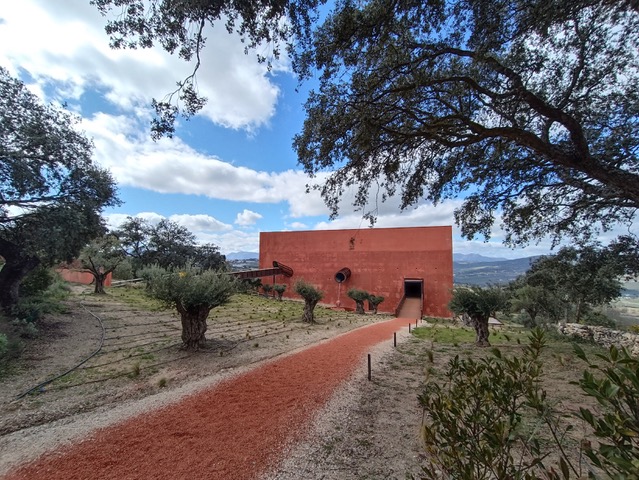
Welcome to LA Almazara. Photo © Karethe Linaae
When the international press writes about the Andalusian inland town of Ronda, they almost always talk about the historic bridge or Spain's oldest permanent bullring. Therefore, it was a big surprise when the prestigious American TIME Magazine chose a brand-new building in the Tajo-city as number one on their list of the World's Best Places to Visit in 2025.
Welcome to LA Almazara, the world’s first signature olive mill designed by internationally renowned designer Philippe Starck. The cubic building that towers over the landscape between olive groves has been both highly praised and condemned. But anyone interested in architecture, design, engineering, industry, art, sculpture or agriculture, should visit what Starck himself describes as “an unusual, incredible and miraculous place where visitors can enjoy a powerful experience that challenges and transforms”.
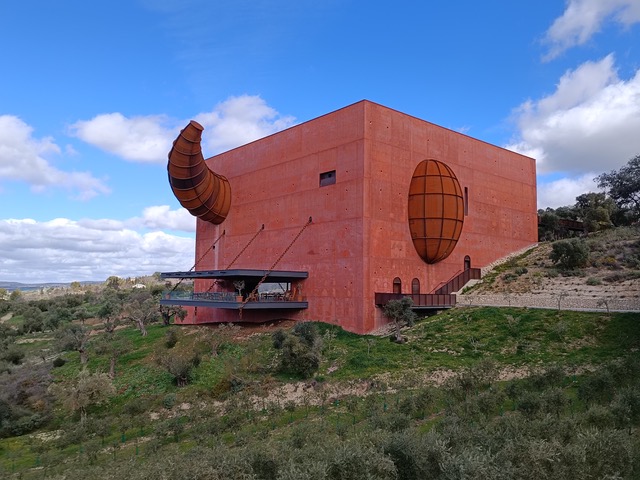
LA Almazara, Ronda. Photo © Karethe Linaae
TIME's annual travel guide, selected by editors and experts from around the world, distinguishes 100 establishments, including hotels, museums, cruise ships, and restaurants, that offer visitors an experience unlike any other. And this year, the number one spot went to the province of Málaga. TIME recognises the completion of a project that has created an authentic ‘cultural revolution’ on the national stage and has brought journalists from around the world to the small city. I had a chance to join their marketing manager, Jorge Amat, and a group of journalists from Madrid and Morocco on a press tour.
Idea from the wine industry
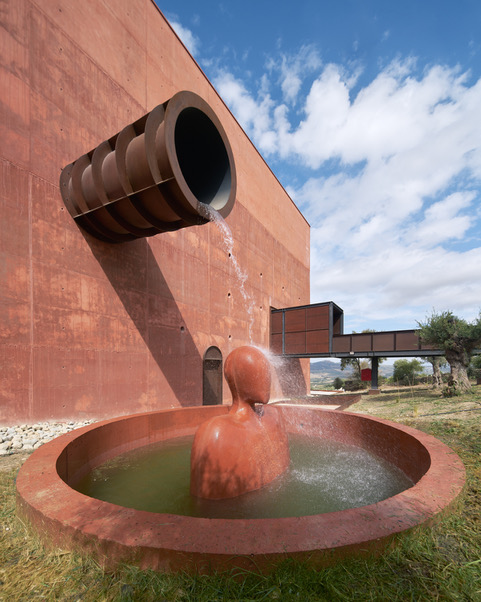
Merging art and industrial design. Photo © LA Almazara
The new demonstration mill facility on LA Organic Olive Farm is located on a 26-hectare property on the outskirts of Ronda, Andalucía. The founders got the idea to create a designer olive oil mill in 2010 after a visit to the Marqués de Riscal signature vineyard in Álava, designed by architect Frank Gehry. The dream of a signature olive mill was born in 2014 with the idea of transferring the concept from wine to olive oil. Since the owners were already producing organic oil and wine at LA Organic with Philippe Starck as partner and designer, Ronda became the natural location. However, it took almost ten years and an investment of over €22 million before LA Almazara could finally open its doors in October 2024.
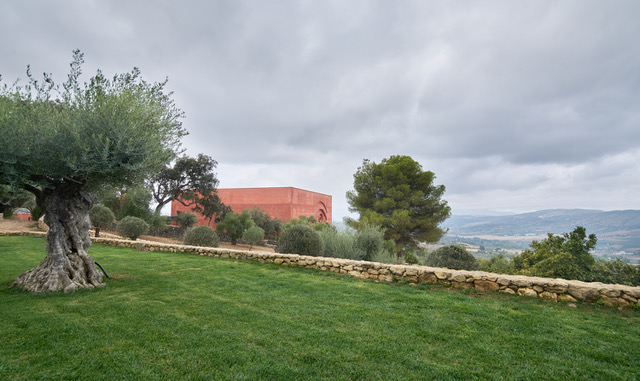
Between the olive trees. Photo © LA Almazara
“We never thought that the reception would exceed all our expectations when we had the idea of creating the first signature oil mill in the world,” says LA Organics CEO, the young and dynamic Santiago Muguiro, who believes that the initiative could mark a before and after in the Premium olive oil sector.
Building or sculpture?
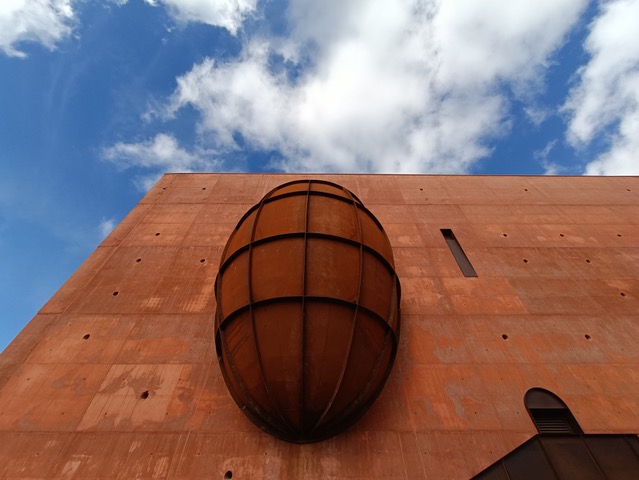
LA Almazara – building or sculpture? Photo © Karethe Linaae
One cannot avoid noticing the 28-meter-high, 3,000-square-meter rust-coloured monolithic cube that looks as if it has been dropped down from space. LA Almazara, a word of Arabic origin meaning Oil Press in Spanish, is surrounded by ancient oaks and 6,500 olive trees growing organically, without fertilizers or pesticides. Every detail of this avant-garde project is created to be simultaneously functional and provocative - one of Starck's distinguishing characteristics.
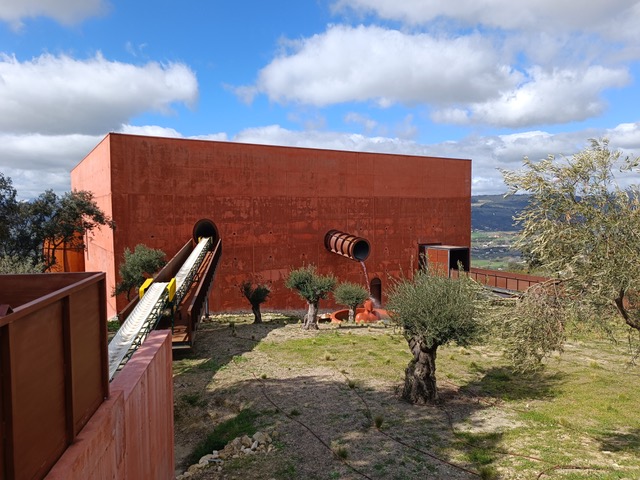
The assembly line for olives leads straight into the building. Photo © Karethe Linaae
"It's more art and sculpture than architecture", he says of the project, which fuses Cubism and Brutalism with industrial design. Yet the building's terracotta hue from natural pigments gives it an overall organic feel.
What might be Starck's most unique work combines architectural innovation with Andalusian agricultural traditions. The design also praises the country's matador traditions, with a giant steel bull horn piercing the building's facade. Therefore, I am particularly impressed when Jorge informs us that all the craftsmen involved in the project were local.
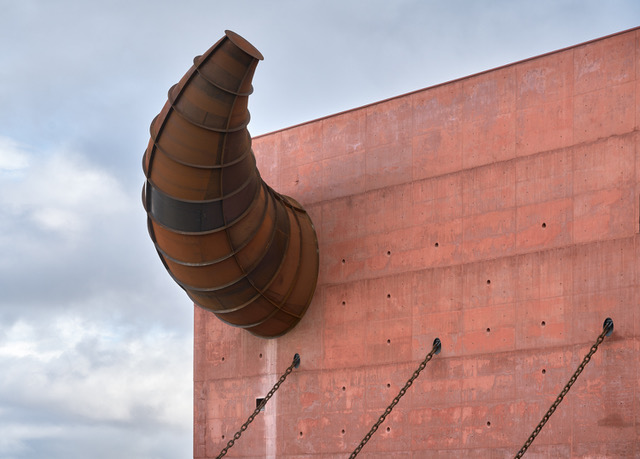
Philippe Strack's design detail exterior. Photo © LA Almazara
Each design element has its unique meaning. In addition to the unmistakable horn, the bull’s symbolic ear is shaped like a colossal olive – a tribute to the fruit and the oil. The bull’s mouth – a spectacular terrace with views of the Sierra de Grazalema – is held up by massive freighter chains, a reference to the Phoenicians who were the first seafarers to settle on the coast of Málaga. One might mistake the fourth element as the eye of Málaga artist Pablo Picasso, says Jorge, but like all artists, Picasso was also influenced by the past. His and now LA Almazara’s eye is a copy of the eye that Phoenician seafarers painted on the bows of their boats, both to protect their ships and crews and to deter enemies.
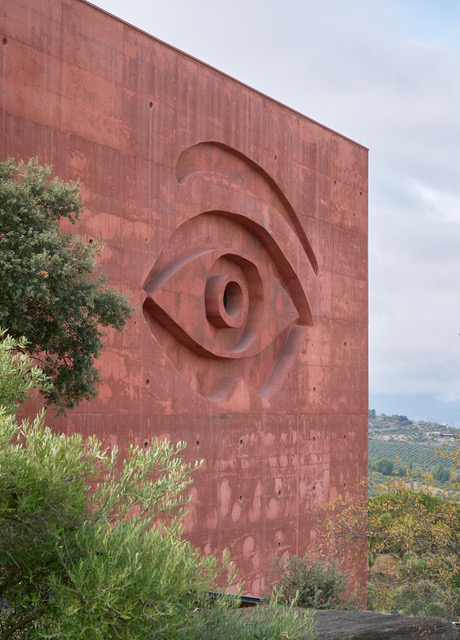
Picasso’s eye has roots back to the Phoenicians. Photo © LA Almazara
In all its artistic splendour, one mustn’t forget that the building has a practical function. Walking towards the entrance, we see the conveyor belt where the olive fruit is brought into the building during the harvest of LA Organics' approximately 80,000 kilos of home-grown olives.
Mill and Museum
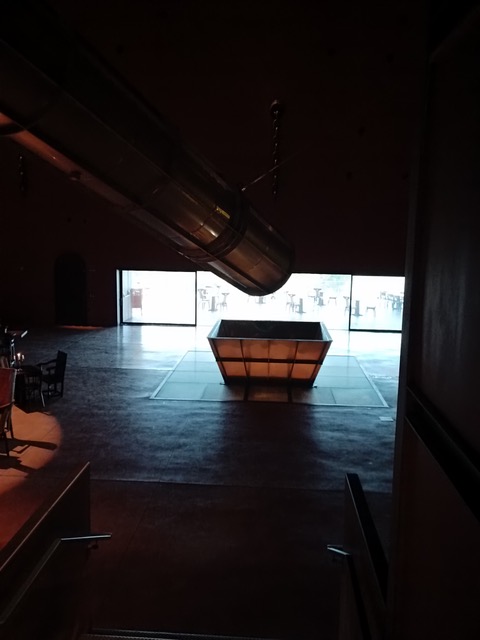
LA Almazara interior. Photo © Karethe Linaae
Perhaps the most astonishing thing about LA Almazara is the transformation from being outside to being almost engulfed by the building's magical and semi-dark interior. The entrance takes us through a narrow hall - a visual transformation to the cube’s interior that is as formidable as the outside yet somewhat intimate.
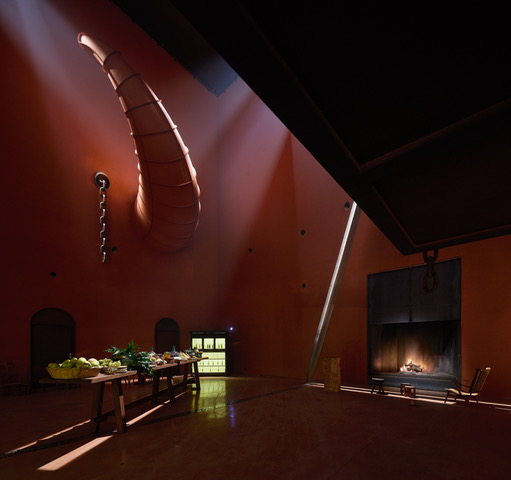
An interior that never ceases to surprise. Photo © La Almazara
“My idea was to show respect for Spain and Andalusia, the most passionate country I have known in my life”, says Starck. He does this, among other things, through a ceiling canvas, painted by his daughter, depicting a woman – the symbol of the country's peasants.
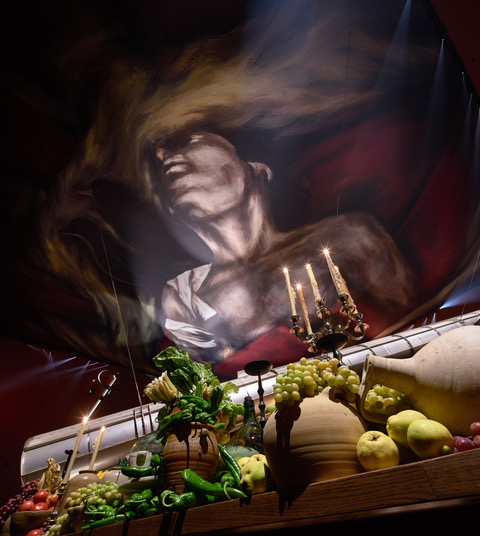
Ceiling art by Ara Starck. Photo © LA Almazara
Starck also pays tribute to two locally born heroes, the legendary bullfighter Pedro Romero (1754-1839), and the scientist, inventor and philosopher Abbás Ibn Firnás (810-887 AD). A forerunner of aviation, the latter designed, constructed and tested the world’s first device to fly for several minutes in the year 875, 600 years before Leonardo da Vinci drew his models of aeroplanes and helicopters. Starck’s replica of his ‘hang glider’ now hangs from the ceiling of LA Almazara.
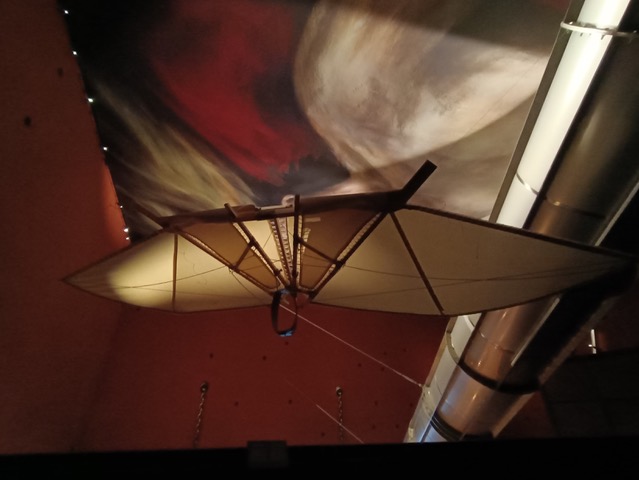
Starck’s replica of Abbás Ibn Firnás (810-887 AD) flying machine. Photo © Karethe Linaae
The oil mill is otherwise fully operational, although only during harvest season when the finest part of the oil production happens here.
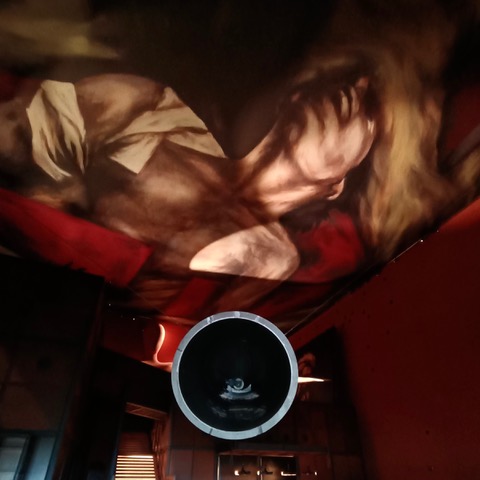
Olive mill interior. Photo © Karethe Linaae
The olives follow an enormous pipe that extends through the building to reach the press and oil tanks on the lower level, which can be seen through floor-based glass panels.
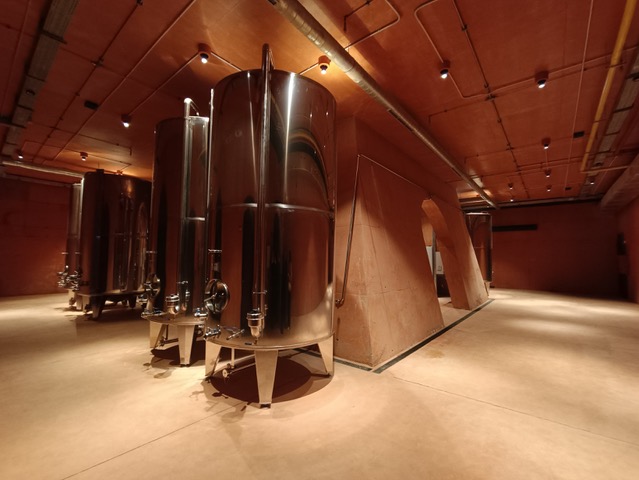
Even the mill in the basement has Starck's signature. Photo © Karethe Linaae
Interactive exhibits show the historical uses of oil, from canning to lighting and soap-making to hydraulic car suspension. The museum tour also demonstrates the unique properties of extra virgin oil for health, nutrition and gastronomy. My personal favourite, however, is the theatrical plaza stage opening to the bull's mouth - an unbeatable terrace with a vista of the surrounding mountains.
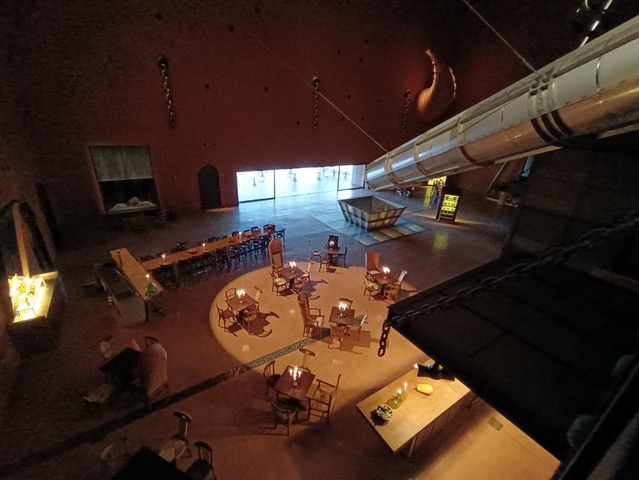
The plaza. Photo © Karethe Linaae
This is part of Starck's paradox: "It's an enormous material substance, but once you enter, the weight of abstraction gives way to pure emotion."
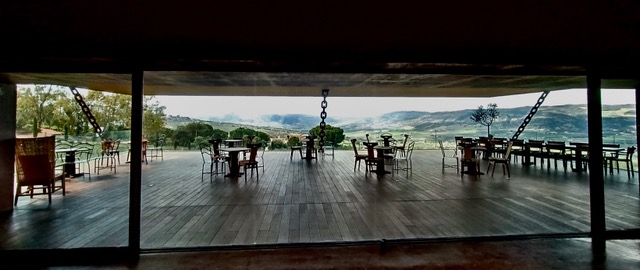
View from La Almazara, Ronda. Photo © Karethe Linaae
LA Almazara has positioned Ronda as a reference point for avant-garde design with a project honouring the region's agriculture, cultural history and olive traditions. Don’t miss visiting next time you head to La Serranía de Ronda!
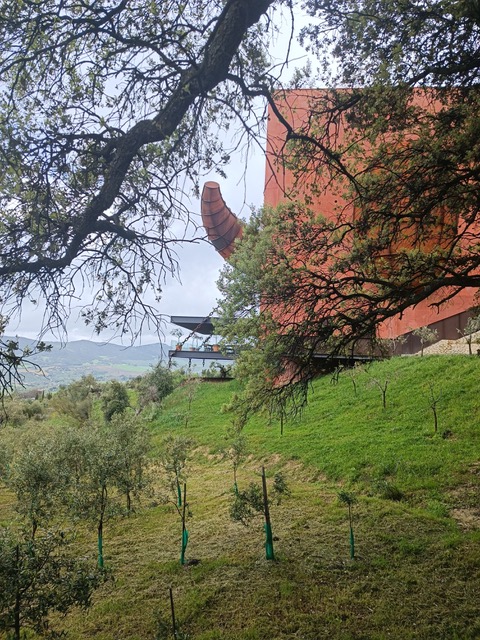
LA Almazara amid nature. © Karethe Linaae